


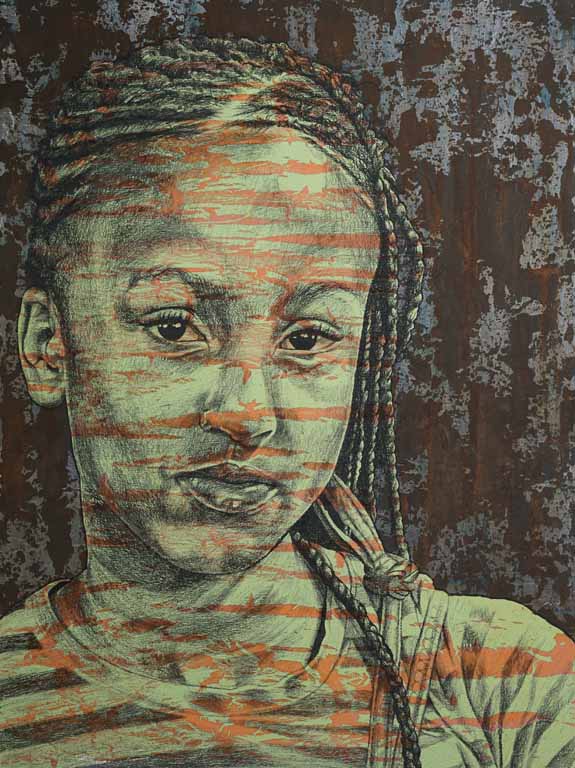 The paintings in this series are visual explorations of how African diasporal societies in the South are fighting social, economic, educational and psychological wars from within and without to survive. The honest and false narratives of history embodied in this series are primarily personified in patinated colossuses that symbolize the culture and realities of the populations they tower over, and the battles we’ve fought and continue to fight. We are at war on two fronts.
The paintings in this series are visual explorations of how African diasporal societies in the South are fighting social, economic, educational and psychological wars from within and without to survive. The honest and false narratives of history embodied in this series are primarily personified in patinated colossuses that symbolize the culture and realities of the populations they tower over, and the battles we’ve fought and continue to fight. We are at war on two fronts.
The extensions of the “Two Fronts” series are comprised of portraits that investigate the catalytic war that atmospheric conditions constantly wage on natural and manmade surfaces and structures. I’m using metal powders, chemical compounds, acrylic and dry media on paper and canvas to recreate those aging and weathering effects on the faces of people, which are reminiscent of the erosive conditions that patina the lives of black people every day, everywhere.
The camoflauge is emblematic of how america has systematically conditioned African americans to accept and blend into an environment that’s hostile and harmful to our people. Despite our intimate knowledge of the conditions that beleaguer the vast majority of black people, many of us knowingly opt to “hide in plain sight” for fear of being recognized as “anti-status quo” and getting punished by the same systems that oppress us.
artwork: Chrishelle, 2017, Acrylic, charcoal and atomized steel dust on paper, 30″h x 22″w


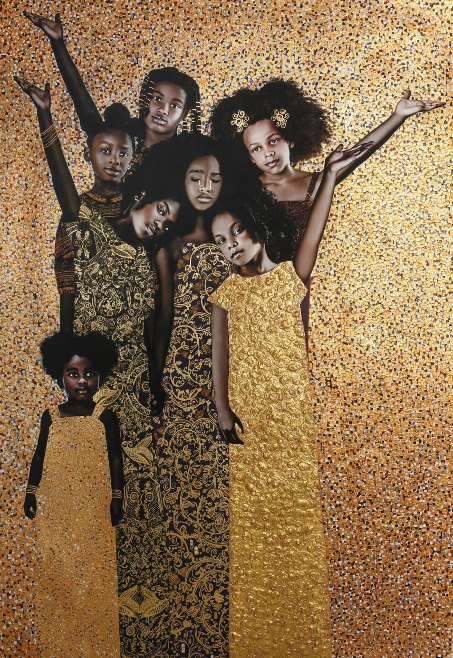 For those who encounter my work, I want them to stop, I want them to pay attention, I want them to not be able to look away
For those who encounter my work, I want them to stop, I want them to pay attention, I want them to not be able to look away
-Tawny Chatmon
Through the lens of photography and the layering of mixed media materials, artist Tawny Chatmon has captured the regality of Black youth. Inspired by the aesthetics of Austrian painter Gustav Klimt’s Golden Phase, Chatmon’s subjects are often depicted in period dresses and then layered with a mixed media of gold leaf, acrylic paint, and detailed with precious and semi-precious jewels. To add a spiritual presence to her subjects, Chatmon employs the Byzantine art aesthetic of elongating their bodies and dress. Consequently, these figures overwhelm the space. Adding emphasis are the grandeur and versatile styles and textures of natural black hair that serve as a celebration of Black beauty. Yet, there is also a stillness of these figures that echoes what Kevin Quashie (2012) describes as “the sovereignty of quiet” in which quiet “is a metaphor for the full range of one’s inner life—one’s desires, ambitions, hunger, vulnerabilities [and] fears.” … Chatmon’s work primarily focuses on creating a safe and healing space for Black childhood in western society, which is feared and often indistinguishable from Black adulthood.
Excerpt from the essay “What I Want You to Know: Chatmon’s Visual Love Letter to Black Children” By Tanisha M. Jackson, Ph.D.
It Was Never Your Burden To…, 2020
24k gold leaf, acrylic, watercolor on archival pigment print
52 x 36″

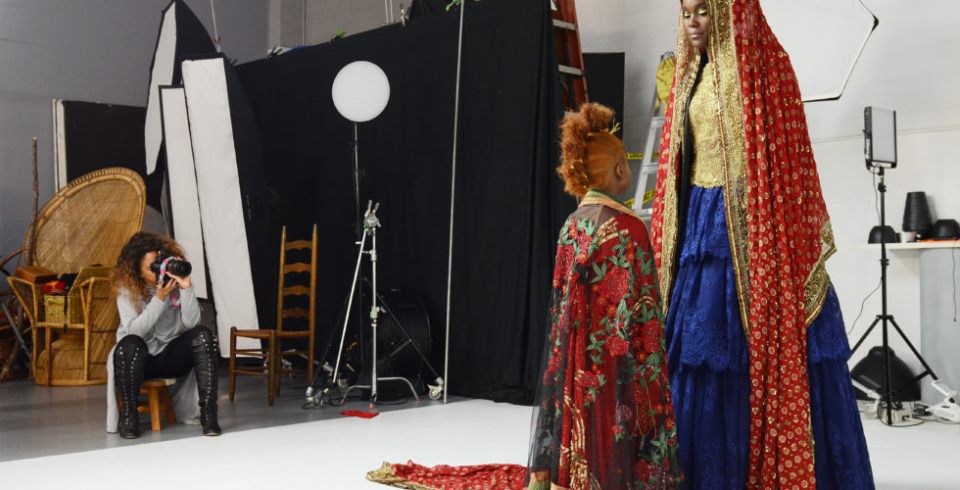
Tawny Chatmon (b. 1979, Tokyo, Japan) is a photography-based artist residing in Maryland. In 2010, the then commercial photographer’s outlook and relationship with her camera shifted when she began photographing her father’s battle with cancer, consequently documenting the disease unexpectedly taking his life. With her father’s passing, she gradually began to look to her camera less as a device for monetary gain and more as a way for her work to serve a higher vocation.
While the camera remains her primary tool of communication, the self-taught artist takes a multi-layered approach in her process. She does not restrict herself to following any set of rules and does not subscribe exclusively to traditional photography practices. Her photographs are often digitally intensified by exaggerating the hairstyles of her subjects (who are often her children and other family members), lending them the eyes of someone older and wiser, and elongating their form, drawing inspiration from the Byzantine period to signify importance. Thereafter, she typically combines overlappings of digital collage and illustration. After refining and printing, she frequently experiments with various art practices by hand-embellishing with acrylic paint, 24-karat gold leaf, and materials such as paper, semi-precious stones, glass, and other mixed media. In choosing to frame the achieved iconography in golden antique, repurposed, and contemporary baroque frames, the artist composes a touching counter-narrative that is more than just a photograph but a new, meaningful compositional expression.
Chatmon suggests that our life experiences and memories are largely responsible for who one ultimately becomes and that “what we are exposed to, what we are taught, and even the toys we play with as children” contributes immensely to shaping us into adulthood. A Black woman and mother of three Black children, she is motivated by “leaving something important behind” to the world her children will grow up in while creating imagery that celebrates and honors the beauty of Black childhood and familial bonds while at times addressing the absence and exclusion of the Black body in Western art.
Chatmon is among the eight African American artists featured in the 2022 Venice Biennale exhibition The Afro-Futurist Manifesto: Blackness Reimagined, curated by Myrtis Bedolla of Galerie Myrtis. The exhibit explores the theme of Black life on the continuum of its imagined future presented in the Personal Structures art fair.
Photographer: Melody F. Dixon

 It is my belief that our memories and experiences are directly responsible for who we become. What we are exposed to, what we read, the toys we play with as children, what we view… I attribute this thought to my desire to make sure I’m sending a clear message (with my work) and that the message I am sending is “saying something” important; because if I believe we are shaped by our memories, as an artist, I must also believe that I too play a small part in shaping and shifting the views of anyone who comes in contact with my work. I did not always think this way but once realized, the thought never left me.
It is my belief that our memories and experiences are directly responsible for who we become. What we are exposed to, what we read, the toys we play with as children, what we view… I attribute this thought to my desire to make sure I’m sending a clear message (with my work) and that the message I am sending is “saying something” important; because if I believe we are shaped by our memories, as an artist, I must also believe that I too play a small part in shaping and shifting the views of anyone who comes in contact with my work. I did not always think this way but once realized, the thought never left me.
The primary theme that drives my art practice today is celebrating the beauty of black childhood. I am currently devoted to creating portraits that are inspired by artworks spanning various periods in Western Art with the intent of bringing to the forefront faces that were often under-celebrated in this style of work.
My camera remains my primary tool of communication, while my constant exploration of diverse ways of expression moves me to add several different layers using a variety of mediums. After a portrait session is complete, I typically digitally manipulate my subjects and unite them with other components to achieve a work that is a new expression. Often lending to them the eyes of someone their elder and more wise and almost always exaggerating and/or emphasizing their hair and features in a celebratory way. Thereafter, I may superimpose antique patterns and textures, collage vintage botanical and wildlife illustrations, or add hand-drawn digital illustration. If I feel I am not yet complete, after each portrait is refined and printed, I may combine paint and gold leaf adding ornamental elements.. By experimenting with various art practices, I allow myself to follow no set of rules while creating instinctually and fluidly. Each layer serves it’s very own meaningful purpose.
It is my hope that with each theme I explore and with each portrait I create, something vital is etched into the memory of the viewer.
-Tawny Chatmon
The Redemption: Castles
Photography, Photo- Manipulation, 24k gold leaf, Acrylic paint
34.5″ x 42″ Framed
2018/2019


Face Off II (detail), Archival Ink Jet Print, 30″ x 40″, 2014 by Larry Cook
September 2 – November 18, 2017
artwork | artists’ talk | the artist’s | film | music | press
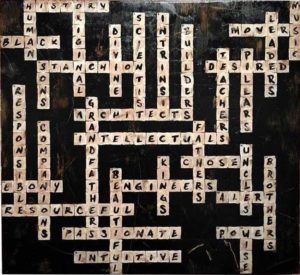
I chose to use the human heart painted Black as a means of representing the Black body. The heart being the core of the body, the drum whose rhythm keeps us moving while Black Americans are the cultural, spiritual, and biological vanguard. The God Seed depicts the biological, giving us a black heart as the nucleus with golden barbed wire as electrons. This speaks to the origins of civilization as we know it; with all roots leading to Africa. While science has proven every human carries DNA strands of the Black woman, we know it takes two to populate – making the Black woman and man the Mother and Father of civilizations. (It would almost seem the Black man is intentionally left out of the equation).
Dark Matter takes us to the astrological tying in cultural and spiritual ties. In science dark Matter is both theoretical, and invisible as it does not reflect light, yet helps to explain things like gravitational forces. These invisible forces I place correlation to that of “soul” – the style and movements of Black men in particular. From the music we’ve created, to how we style our clothing, to the way we strut down a sidewalk, our soul is magnetic. It is an attracting force people worldwide gravitate toward with hopes to bask in the feeling and replicate for themselves. This desire to be entangled in our soulfulness I interpret almost as a form of worship. Dark Matter is presented to the viewer as a salvaged relic-like object—broken and missing pieces yet preserved and placed on display for all to see. The rusted and broken hinges give the sense that this three-part panel was once connected, possibly unfolding from the center, offering a visual presence reminiscent of alters in catholic churches.
Factualism is simply a meditation on whom and what Black men truly are. It is meant as the antithesis of what pop culture and the news m/entertainment media present us as. It’s an exercise in defining oneself and taking hold of one’s own agency. It’s the presentation of another set of facts not often put on display. The words and ideas are given to the viewer in the form of a crossword puzzle to help think about how these ideas intersect and build off one another, giving viewers a new set of images to aid contextualizing their thoughts on Black men.
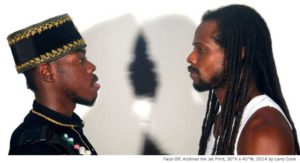
Do For Self and The Call pay homage to black liberation philosophies that arose out of organizations such as the Nation of Islam and the Moorish Science Temple. Each work references a sector of Black trade and industry that is a part of our cultural memory. In Do For Self, oil based colognes signify vendor customs established within the black community. In The Call, a reproduction of the Nation of Islam’s weekly The Final Call observes that recordings of personal histories within black community can equate to economic independence, self-worth, and empowerment.
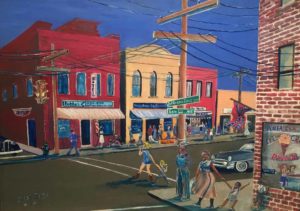
“Johnnie Lee Gray’s Paintings in the Context of Jim Crow” Book title: Rising Above Jim Crow: The Paintings of Johnnie Lee Gray. Published by New York Life. Excerpt from essay written by Gwen Everett, PH.D.
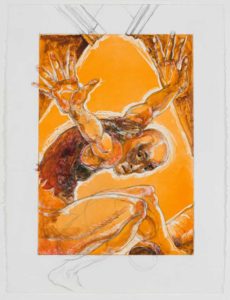
The exhibition Black Man in a Black World couldn’t be more timely, when demonstrations of bigotry and hate are assigned the moral equivalency of people fighting for human dignity, equality and justice for all members of the human family. African Americans and all marginalized people need to be heard, recorded and acknowledged for what they have endured, for their significance, and for their strength. Through my paintings I consider historical and contemporary truths attempting to reveal the dignity, endurance, and genius of African Americans hoping to evoke dialogue and reflection on implicit bias and resulting perpetrated injustices committed towards people of color in this country.
In this body of work, it is my intent to “flip” the role of the Black Man from the degradation of subservience to the triumphant role of hero using images traditionally assigned to white males.
The Fighter exemplifies the Black Man’s clash against oppression, degradation and exploitation. The daily assaults and dog whistle status reminders requires nothing less than emotional resistance, determination and resilience.
Minstrel’s Guide this black harlequin harks back to the 1500s as he moves into the viewer’s space to then morph into the minstrel of the 1800-1900s. Minstrels were derogatory characterizations, created by the dominant culture as entertainment to ridicule blacks after the Civil War.
Sampson Brings Down the House recalls the biblical image of a white curly locked Sampson tearing down the temple. Here it is flipped, showing a Black Sampson tearing down the house of injustice. It is my intent to show the strength and prowess of the Black Man in overcoming enormous odds.
Push Back depicts the strong Black male pushing back against racism, bigotry, hatred, inequities, prejudice, discrimination, white supremacy, etc., etc…..
Strange Tale is based on the mythology of Europa and Jupiter, here used to represent the “peculiar institution” of slavery and its aftermath.
The work Sampson and the Lion is based on the biblical story of Sampson slaying the lion that roared against him, flipped here to show a strong Black Sampson combating oppression.
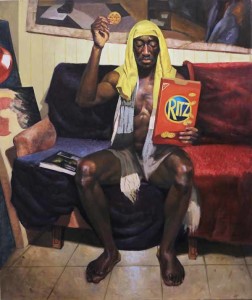
Growing up we feared for our lives. Dropping the wafers or chewing too fast would result in going to hell, so we would impersonate Jesus distributing the holy wafers, to practice receiving the Eucharist correctly. Ritz crackers were usually the practice food of choice to simulate the daunting experience, not to mention they were addictive. Since Jesus was white, according to Catholic imagery, a shirt was always used as a wig to help sell the idea of flowing hair.

exhibition | about david carlson


Johnnie Lee Gray was born in Spartanburg County, South Carolina in 1941. In his early years Gray demonstrated artistic talent, painting and drawing as a way to express his emotions and depict his surroundings. Working alongside his grandparents in the fields of their sharecropper farm, and later as a carpenter, textile mill worker, house painter, Gray learned early on to use the materials of his milieu to create works of art that drew on his memories and experiences as a black American man. read full biography